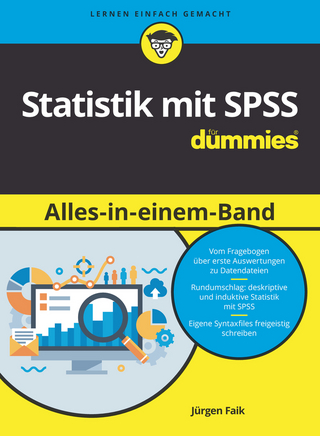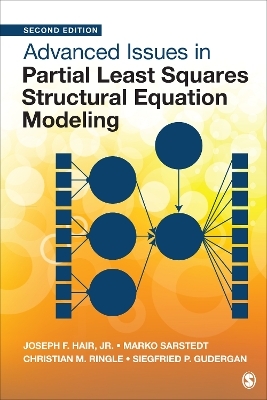
Learning Statistics Using R
SAGE Publications Inc (Verlag)
978-1-4522-8629-7 (ISBN)
- Keine Verlagsinformationen verfügbar
- Artikel merken
Providing easy-to-use R script programs that teach descriptive statistics, graphing, and other statistical methods, Learning Statistics Using R shows readers how to run and utilize R, a free integrated statistical suite that has an extensive library of functions. Randall E. Schumacker’s comprehensive book describes in detail the processing of variables in statistical procedures. Covering a wide range of topics, from probability and sampling distribution to statistical theorems and chi-square, this introductory book helps readers learn not only how to use formulae to calculate statistics, but also how specific statistics fit into the overall research process.
Learning Statistics Using R covers data input from vectors, arrays, matrices and data frames, as well as the input of data sets from SPSS, SAS, STATA and other software packages. Schumacker’s text provides the freedom to effectively calculate, manipulate, and graphically display data, using R, on different computer operating systems without the expense of commercial software. Learning Statistics Using R places statistics within the framework of conducting research, where statistical research hypotheses can be directly addressed. Each chapter includes discussion and explanations, tables and graphs, and R functions and outputs to enrich readers′ understanding of statistics through statistical computing and modeling.
Dr. Randall E. Schumacker is professor of educational research at the University of Alabama. He has written and co-edited several books, including A Beginner’s Guide to Structural Equation Modeling, Third Edition, Advanced Structural Equation Modeling: Issues and Techniques, Interaction and Non-Linear Effects in Structural Equation Modeling, New Developments and Techniques in Structural Equation Modeling, Understanding Statistical Concepts Using S-PLUS, Understanding Statistics Using R, and Learning Statistics Using R. Dr. Schumacker was the founder and is now emeritus editor of Structural Equation Modeling: A Multidisciplinary Journal, and has established the Structural Equation Modeling Special Interest Group within the American Educational Research Association (AERA). He is also the emeritus editor of Multiple Linear Regression Viewpoints, the oldest journal sponsored by AERA (Multiple Linear Regression: General Linear Model Special Interest Group). Dr. Schumacker has conducted international and national workshops, has served on the editorial board of several journals, and currently pursues his research interests in statistics and structural equation modeling. He was the 1996 recipient of the Outstanding Scholar Award and the 1998 recipient of the Charn Oswachoke International Award. In 2010, he launched the DecisionKit App for the iPhone, iPad, and iTouch, which can assist researchers in making decisions about which measurement, research design, or statistic to use in their research projects. In 2011, he received the Apple iPad Award. In, 2012, he received the CIT Faculty Technology Award. In 2013, he received the McCrory Faculty Excellence in Research Award from the College of Education at the University of Alabama. In 2014, Dr. Schumacker was the recipient of the Structural Equation Modeling Service Award at AERA.
PART I. Introduction and Background
1. R Basics
2. Research Methods
3. Probability
4. Sampling and Populations
PART II. Statistical Theory and Inference
5. Central Limit Theorem
6. Sampling Distributions
7. Statistical Distributions
PART III. Descriptive Methods
8. Graphing Data
9. Central Tendency and Dispersion
PART IV. Statistical Methods
10. Hypothesis Testing
11. Chi-Square Test for Categorical Data
12. z Test for Differences in Proportions
13. t Test for Mean Differences (2 groups)
14. F Test for Mean Differences (3 or more groups)
15. Correlation Tests of Association
16. Linear Regression Tests of Prediction
17. Multiple Regression
18. Logistic Regression
19. Loglinear Regression
PART V. Replication and Validation of Research Findings
20. Replication of Statistical Tests
21. Synthesis of Research Findings
Glossary of Terms
Glossary of Packages, Functions, and Commands Used in Book
Statistical Tables
Guide for Selecting a Statistical Test
| Erscheint lt. Verlag | 3.4.2014 |
|---|---|
| Verlagsort | Thousand Oaks |
| Sprache | englisch |
| Maße | 187 x 231 mm |
| Gewicht | 950 g |
| Themenwelt | Schulbuch / Wörterbuch ► Lexikon / Chroniken |
| Mathematik / Informatik ► Mathematik ► Computerprogramme / Computeralgebra | |
| Mathematik / Informatik ► Mathematik ► Statistik | |
| Sozialwissenschaften ► Politik / Verwaltung ► Staat / Verwaltung | |
| Sozialwissenschaften ► Soziologie | |
| ISBN-10 | 1-4522-8629-9 / 1452286299 |
| ISBN-13 | 978-1-4522-8629-7 / 9781452286297 |
| Zustand | Neuware |
| Informationen gemäß Produktsicherheitsverordnung (GPSR) | |
| Haben Sie eine Frage zum Produkt? |
aus dem Bereich


